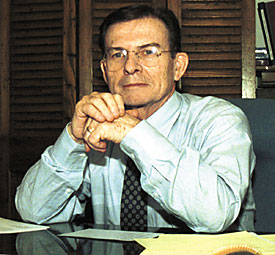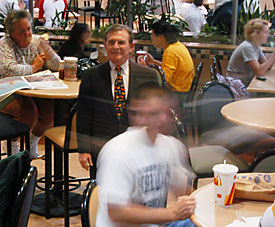 |
|
JON HELGASON/ Arizona Daily Wildcat
|
Next month will mark President Pete Likins' fifth year at the UA, since coming from Pennsylvania's Lehigh University in 1997.
|
|
By Keren G. Raz
Arizona Daily Wildcat
Wednesday October 23, 2002
From weathering a CatCard scandal to revamping campus and defining a new mission, Likins says he's only just begun
Maybe you think he's considering slowing down at age 66. You'd be wrong. Most of the time, President Pete Likins works late into the evening, often attending a business dinner engagement with his wife, Pat, of 47 years, as was the case last week, when he attended a dinner for the UA Foundation at the Westin La Paloma Resort.
Before the dinner began, Likins and his wife took a time-out. Relaxing against the pillows in a private lounge area, Pat Likins posed the question that is always on her mind: When will her husband finally retire?
"I probably shouldn't say this, but I'm just looking forward to the time that he finally gets old enough to retire. Well, he's old enough now, but he doesn't think so," she said.
"I told the regents three to five years, and then I'll retire," Likins responded.
Laughing, Pat Likins said, "He told me that five years ago, when we first came here."
Next month marks Likins' fifth year as UA president ÷ a year that may also prove to be a turning point in UA history with his Focused Excellence proposal, which he will present to the Arizona Board of Regents next week. With the opportunity to redirect the mission of the university, Likins doesn't want to step down from the presidency any time soon.
"What you expect of yourself is leaving a university significantly better than it was when you came, having a permanent impact on the university. And right now I have that opportunity," he said. "For me, the biggest challenge is right now."
Likins couldn't fathom turning down the challenge. So despite Pat Likins' wishes, he is pushing back his retirement. As he sees it, his job here at the university has just begun.
 |
|
Saul Loeb/ Arizona Daily Wildcat
|
President Pete Likins stands in the middle of the Student Union Memorial Center food court as students eat and rush around him on a Friday afternoon. Next month marks Likins' fifth anniversary as president of the UA. In that time, he's dealt with budget cuts, been criticized for the sale of student information and faced workers rights' controversies.
|
|
Wanted: a CEO type of leader
He was used to 40-degree temperatures in November after living in Bethlehem, Pa., for 15 years.
But when Likins came to Tucson in 1997, he didn't just come for the 70-degree winters.
He came to serve as UA's 18th president, having been unanimously approved by the Arizona Board of Regents over the summer.
At the time, Lehigh University, a private university in Bethlehem, Pa., had a student population of 6,300.
In 1997, UA had a student population of 35,000.
Regardless, regents felt he was the strongest candidate.
"We wanted a CEO type of person. A CEO who could've run the organization like a business and have a thorough understanding of academia," said former Regent Hank Amos.
They believed they found their CEO in Likins.
A Look Back
A quick glance at the career of Pete Likins as UA President
· July 1997 Arizona Board of Regents unanimously votes to appoint Pete Likins as the 18th president of UA.
· November 1997 Likins officially inaugurated as president.
· April 1999 Likins is confronted with a 10-day sit-in protest by the Students' Against Sweatshops.
· January 2001 Likins takes to the airwaves in order to raise money for UA.
· October 2001 Likins announces the closing of the Arizona International College.
· January 2002 Battle over the future of the cactus garden begins.
· June 2002 The International Genomics Consortium, which Likins had been encouraging support for since February, announces that it will come to Arizona.
· July 2002 Likins' son John dies.
· September 2002 Likins introduces "Focused Excellence."
|
However, as CEO of a large public university, Likins has had a harder time getting to know as many students as he was able to at Lehigh.
As a result, many students on campus still know little about their president.
"He's not that visible to students," said Cindy Stella, communications senior.
Noah Molotch, a graduate student in hydrology, has only had one encounter with Likins.
"The only interactions I've had with him was when I spoke at the hearings for a tuition increase. He seemed to listen to my comments genuinely, but I don't know if his actions reflected that," he said.
Connecting to students is one of the aspects of being a president that Likins wishes he had more time for.
But his wife said Likins has done a lot more than he realizes.
She pointed to alumna Cheri Blauwet, who connected to Likins at the start of her freshman year.
After talking with Likins at a reception for National Merit Scholars, Blauwet, a member of the wheelchair racing team, introduced him to the disabilities sports programs.
"Ever since, he has been an amazing advocate for our program. He has represented us in matters with the university in which have tried to gain equal access to varsity sports programs and services and helped us in the search for scholarships that we can award to our new elite athletes," Blauwet said.
Likins has made an effort to meet more students than just student athletes.
He has also exceeded student governments' expectations for involvement by showing up for town halls, student breakfasts and other student activities, said student body president Doug Hartz.
Turbulent times
Last month, Likins stood before the board of regents and presented "Focused Excellence," his vision for a UA with increased tuition, higher admissions standards and fewer programs in order to deal with decreased state funding.
UA took $16.6 million in state budget cuts last year, and earlier this month, Likins and other administrators issued a bulletin asking for deans to submit proposals detailing how they will cut an additional 5 percent in order to absorb a potential $33 million loss of state funds.
One year ago, Likins took the first controversial step to alleviate budget woes, announcing the closure of the Arizona International College.
Then, over the summer, Likins met with controversy again when he accepted a $148,394 pay raise in the middle of the budget crisis.
Scandals aren't a new part of Likins' presidency.
In fact, he's faced a number of them over the past five years, some of which have yet to be resolved.
 |
|
" · So in some sense I've just begun the great adventure of my presidency."
- Pete Likins
UA President
|
 |
In 1997, UA released the Social Security numbers of students, faculty and staff to Saguaro Credit Union and MCI Telecommunications Corps when students were first issued CatCards.
Likins accepted responsibility for the incident.
The person who released the records was never named.
The scandal shook up the UA community and led the Arizona Legislature to pass a law that now requires the universities to stop automatically using new students' Social Security numbers as identification numbers.
In April 1999, Student Against Sweatshop Activists confronted Likins with a ten-day sit-in protest, taking over the seventh floor of the Administration building.
Thirty students protested his refusal to sign a labor rights resolution to increase workers' rights in overseas factories that manufacture UA apparel.
Likins said he understands that the protesters probably still do not agree with him today.
"I am comfortable with my relationships with the SAS, although they might not all agree. I think we did some good work together," he said.
The sit-in protest may be over now, but the issue is not, said Rachel Wilson, SAS spokeswoman.
"His dealings with us have been dirty," she said. "He makes promises he doesn't keep."
More recently, Likins encountered student protesters and environmentalists in the battle over the historic Joseph Wood Krutch Cactus Garden. He initially supported plans to move the cactus garden in order to build the alumni plaza.
However, after a serious outcry from the UA community, the proposal to move the garden was defeated.
Under a new plan, the cactus garden will be left where it is and expanded.
The plaza south of the Administration building has yet to undergo construction.
Outside the UA borders
When Miklos Szilagyi, professor ofelectrical engineering and faculty senator, thinks of one of Likins' achievements, he thinks of "massive construction."
Since Likins arrived at the university, the $20 million Integrated Learning Center has been built, the Student Union Memorial Complex is almost completed and a new building for office space ÷ the Learning Services Building ÷ will be dedicated Friday.
But not everyone is happy about the changes they are seeing on campus.
"In the competition of resources between construction and services for students and faculty salaries, construction won," said Carol Bernstein, associate professor of microbiology and immunology.
Likins' influences reach beyond campus.
Likins has been developing a relationship to foster Tucson's economic development and high tech industry by initiating a number of joint university-city ventures, said Bob Walkup, mayor of Tucson.
Some of the projects include a new science center that will be located in downtown, and there is also talk about pursuing faculty and student family housing downtown.
The challenge begins
During the he past five years Likins has also been forced to deal with loss of faculty and cuts in funding from the state, a trend he'd like to deal with, if not reverse, before his time here is over.
"He's run the university with his hand tied behind his back and, you could say, one of his legs too," said Hank Amos. "All he's been able to do the last five years is cut the budget. He's been in defensive mode."
The "brain drain" has been a reality for Likins since he took the presidency.
Three hundred thirty-three UA employees lost jobs during fiscal year 2002, according to a financial planning bulletin released by UA administrators in July.
For faculty, the average salary for a full-time professor is about $10,000 less than at peer institutions and $9,000 less than at public institutions, according to the Association of American Universities.
Despite the struggles, Regent Fred Boice said, "He's just an absolute leader of proven success. He has been able to keep faculty and staff together physically and mentally through tough times."
Not only has he led the university through tough budget times, but also through tough personal times.
This summer, Likins mourned the death of his son, John, after years of helping him through problems with drug addiction and schizophrenia.
Likins said John's death was the lowest point of his time here at UA.
While Likins struggles to cope with the loss of his son, he tries to focus on what lies ahead, both the obstacles and the opportunities.
"We're kind of perpetually expecting everyday to be better than all the days behind us. That's just the way we live our lives," he said.
In his mind, tomorrow and next month's anniversary only mark the beginning of his presidency.
"I was president of another university for 15 years, and I know I left it a very different place than it was when I got there, and that's gratifying," he said. "That makes you feel like you're really shaping the permanent character of the institution. I'm feeling that way only now at Arizona after five years. So I've in some sense just begun the great adventure of my presidency."

